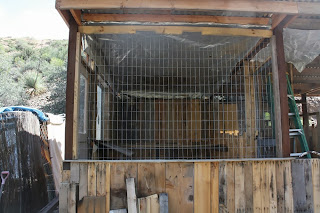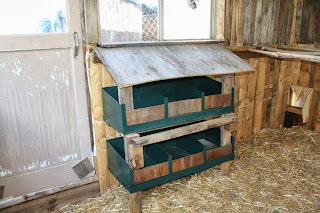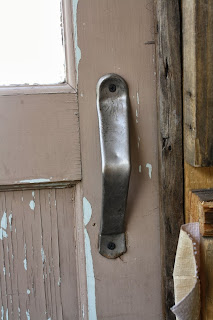 |
| West end door |
Well the new layers coop is almost done! While there are some small finish details yet to be done, like putting wire over the vents at the top of the walls, it is almost ready for occupancy.
Here is the west end, the door is hung, tho I still need to put a latch on the outside, it is nicely level and plumb and moves easily.
I do need to go dig around in the shed for a piece of plexiglass I have to put in the other window pane, but it's still pretty warm so I'm not going to worry about that right now.
 |
| Front of the layer's section with 2x4" weld wire |
The front opening has 2x4" weld wire over it on the inside. I am still debating whether I will put my old windows on this wall or not. I"m really considering building a 4' awning style roof on the front for shade and to keep the wind from blowing in the rain and leaving it open. If I need to this winter I can always staple on some plastic during the worst of our weather.
 |
| the roosts |
The roosts run along the back, all at the same height so there will be no jostling for top hen spot. The entire back wall of the building and the first four feet or so of the end walls are solid except for a small open vent at the top. This will keep them from being in a draft while they sleep. In the lower left of the back wall you can see an opening for a pop door. I am making all the openings while I am building. Then I will board them over until I get the pens done on the outside.
 |
| nest boxes of recycled candy bins |
The nest boxes started out life as candy bins. Some friends gave them to me and they were very rusty. I sanded, primed and painted them. The wooden leg supports are not fastened to them and the bins are not fastened to the wall. That way I can take them completely apart for cleaning if I need to. The wooden fronts slide out so most of the time I can just take them out and sweep the boxes clean. The slanted roof will hopefully keep them from roosting on top.
 |
| inside door handle |
The door handle on the inside is made of a piece of aluminum I found laying around. I have no idea what it was before, I just beat it with a hammer until it was the right shape and screwed it on.
 |
| simple door latch, open position |
The door to the next section inside is an old screen door with some fencing and chicken wire added onto it. It swings into the layer's section and I needed a simple latch to keep it shut. This is a small piece of board and one screw.
 |
| latch closed |
Here it is in the closed position.
 |
| in the down position |
The cool thing about this is that if the screw ever loosens up in the board allowing it to move freely and it falls downward, it will still hold the door shut.
Before the girls can move in I need to put the latch on the outside door and put in some feeders and a water system. Maybe after lunch!


